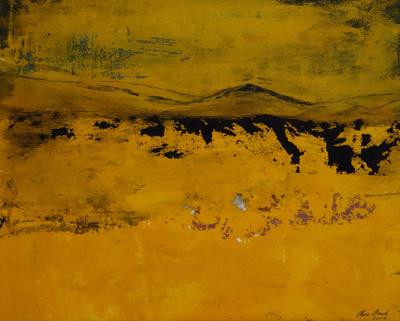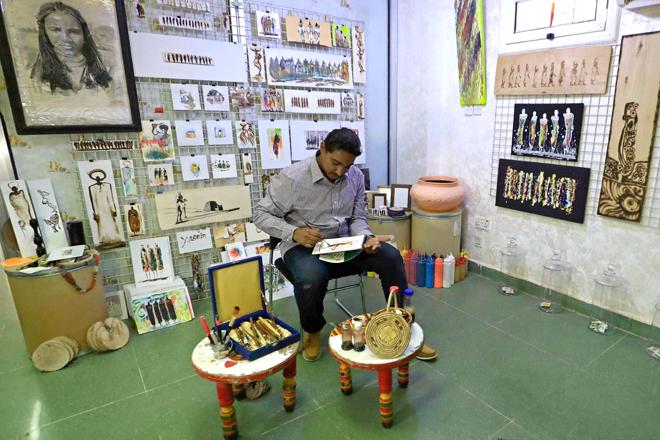You are here
New phase of artistic voyage on the horizon
By Ica Wahbeh - Oct 13,2016 - Last updated at Oct 13,2016

Painting by Clara Amado on display at Nabad Art Gallery through October 26 (Photo courtesy of Nabad Art Gallery)
No other title could have better projected the meaning Clara Amado’s works, and surely the artist herself, wish to convey to the viewer.
“The Light of Change” is an exhibition of a somehow “changed” style and imagery in the works of this artist’s long career, but also an allusion to a change in her life, for, Amado has decided to leave Jordan, “my second home” for the equally warm and blue skies of her native Barcelona.
This, possibly last in Jordan, exhibition at Nabad Art Gallery is, in the words of Instituto Cervantes Director Antonio Lázaro-Gozalo, a “search for the possibility of a different perspective and understanding of the self”, a continuation of the process of “self-examination and self-analysis, and everything else implied: isolation, identity, constancy, devotion, estrangement, construction of memories and reassessment of life options”.
She explores such different perspectives and the result of this inner analysis by contrasting light and shadow, juxtaposing dark blocs of colour to fine, luminous lines to create a minimalist landscape that even in the small paintings can send to the immensity, and solitude, of the desert where she seems to be searching for an elusive meaning that might, in the crepuscular light of a spectacular sunset, make itself clear.
Earthen colours — ochre, brown, beige, pale yellow — on their own, make her landscapes pure. Like a thought that comes to illuminate and make sense, these colours, with an occasional golden ray breaking through, create images that are bright, sensible and immutable.
When mixed, the colours create infinite possibilities and degrees of shades, moving gradually from light to dark, hinting, perhaps, at life come full circle or, in the sombre mood around, at the darkness that slowly descends on this area.
But the mood is not bleak. It elicits a wide range of feelings, just like life would.
Abstract images of clearly delineated spaces at times become more figurative, assuming the shape of barren mountains of overwhelming beauty hiding some glowing valleys, not unlike Jordanian landscape on the way to the south.
Rolling hills — or are they waves? — are brighter, in beautiful shades of blue, moving away from the brownish landscape and preparing for the unexpected explosion of red poppies on an orange field that arrest the eye and do not fail to make happy.
Mirror images of a playful sort form lively projections against indigo blue or black backgrounds. Small frames hold symbolic images — Petra’s siq, the outline of the Dead Sea, a simplified country map, deep crevices or stylised human silhouettes, the imagination is free to interpret — only to then make space for bigger canvases in black, blue and ochre tones.
A purely black canvas is bisected by a golden line like a glittering gash: light attempting to free itself from the darkness surrounding it, and prevailing.
Amado’s works pay homage to Jordan’s landscape. She uses Petra and Wadi Rum sand, together with other natural pigments, to recreate vast, warm deserts, forbidding mountains, a hint of blue waters and serenity.
Maroon, red and blue are used occasionally, but mostly it is ochre, orange, yellow, beige and brown, defined by black.
The images linger on the retina long after being viewed.
It is a touching exhibition, for the imagery it depicts, for bearing witness to Amado’s artistic voyage and because she is leaving the local artistic scene, left poorer for that.
The artist studied drawing, painting, graphic art and mural painting in Barcelona, Spain, Mexico and Italy. She held 27 solo exhibitions and participated in many group exhibitions regionally and around the world. Her works are in public and private collections in an array of countries.
This exhibition runs through October 26.
Related Articles
A more appropriate title could not have been given to Clara Amado’s exhibition at Instituto Cervantes. For, the word “Horizons” perfectly describes the images on display and they, in turn, open for the viewer infinite perspectives, both perceptible and imaginary.
AMMAN — Throngs of people huddled under a torrential rain, images blurred by streaks of water, dissipated, diluted colours are all images cr
KHARTOUM — Sudanese artist Mutaz Al Fateh creates vibrant pictures with special ingredients; the paint he uses is made with colours derived

















